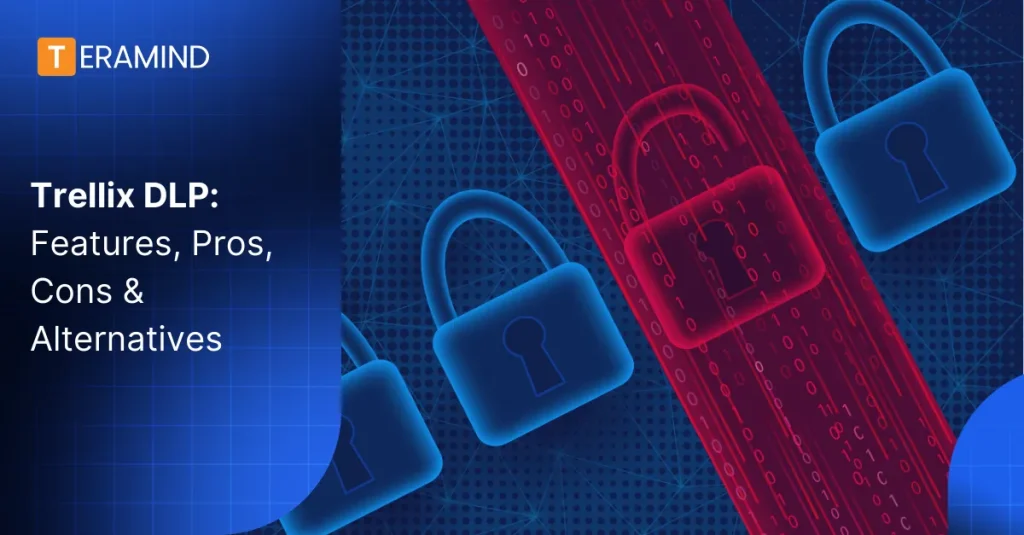Data loss prevention (DLP) solutions are crucial for organizations to safeguard sensitive information from accidental or malicious data leaks. Trellix, formerly known as McAfee Enterprise + FireEye, is a cybersecurity company that offers a comprehensive DLP solution to address this pressing need.
Trellix’s DLP platform stands out for its comprehensive approach, identifying, monitoring, and protecting sensitive data across various channels, including email, cloud applications, and endpoints. This article will delve into the extensive features of Trellix DLP, weighing its pros and cons, and discussing potential alternatives.
What is Trellix DLP?
Trellix DLP is a data protection solution designed to help organizations prevent sensitive content from being accessed, transmitted, or shared without authorization. It employs advanced content inspection techniques, such as data fingerprinting, regular expressions, and keyword matching, to identify and classify sensitive information like personally identifiable information (PII), intellectual property, and financial data.
Trellix DLP offers a range of features, including incident management, reporting, and integration with other security solutions. These features enable organizations to streamline their data protection efforts, maintain compliance with industry regulations and internal policies, and enhance their overall security posture.
With the software, you can provide comprehensive protection for potential leak channels, including removable storage devices, cloud, email, instant messaging, web, printing, and file-sharing.
Key Trellix DLP Features
- Trellix DLP Endpoint Complete: Formerly known as Trellix DLP Endpoint, this feature protects sensitive and proprietary data on Windows and macOS workstations and servers from data exfiltration, offering data discovery and classification tools, user coaching, content filtering, monitoring, and blocking.
- Trellix Device Control safeguards devices from unauthorized installation and provides content monitoring, filtering, and blocking capabilities. It can be included inthe Trellix data loss prevention endpoint complete or available as a stand-alone solution.
- Network Prevent: This protects sensitive information over networks, email, and the web, offering exact data matching, information capture, data exfiltration prevention, and available optical character recognition (OCR).
- Network Monitor: This feature scans network data in real-time to detect traffic anomalies, providing exact data matching, information capture, data collection for faster investigations, and available OCR.
- DLP Discover: This feature offers visibility across networks and file repositories to find and classify sensitive and proprietary data. It features exact data matching, rights management, auto-classification for sensitive data, inventory, copy, and move file capabilities, and optional OCR.
Trellix DLP Pros
Organizations seeking to fortify their defenses against data breaches and maintain regulatory compliance can rely on the extensive capabilities of Trellix DLP. It offers a multifaceted approach to detecting and preventing data loss. Among its key strengths are:
Centralized Monitoring and Event Tracking
Trellix DLP provides a single console to manage deployment, administer policies, monitor real-time events, and access out-of-the-box reports to ensure compliance. This centralized approach streamlines the management of data loss prevention efforts, ensuring efficient and effective monitoring and incident response.
Real-time Alerts & User Coaching
Trellix offers real-time feedback to coach users through educational pop-ups based on corporate policies. These bite-sized educational opportunities help shape corporate security awareness and culture, empowering users to make informed decisions and reducing the risk of accidental data leaks.
Customizable Rules
Trellix DLP allows organizations to define customizable security policies across the organization, creating reusable rule sets according to office, department, regulation, and more. This flexibility enables organizations to tailor the solution to their specific needs, ensuring that sensitive data is protected per their unique requirements and compliance obligations.
Trellix DLP Cons
Trellix DLP offers robust data protection capabilities, but like any other technology, it has areas where it could improve. Below is an analysis of its limitations, which may affect its suitability for certain environments and use cases.
Limited Monitoring Channels
Trellix DLP provides data protection across multiple threat vectors, including endpoints, removable devices, email, web, networks, and data storage. However, its monitoring channels are not as extensive as some may require. It focuses on protecting sensitive information primarily through network monitoring and endpoint control, which might leave gaps in coverage for organizations needing broader monitoring across all data movement channels.
No Geolocation Tracking
One notable omission in Trellix DLP’s feature set is geolocation tracking. This means that organizations cannot track the physical location of their endpoints, which can be a critical requirement for ensuring compliance with regional data protection regulations and monitoring data movement in a geographically dispersed workforce.
No User & Entity Behavior Analytics (UEBA) Solution
Trellix DLP lacks a dedicated UEBA solution, which is essential for detecting and responding to insider threats and compromised accounts. UEBA solutions analyze user behavior patterns to identify anomalies that may indicate security risks, a feature that is becoming increasingly important in the modern threat landscape.
OCR Only Scans File Images
The optical character recognition capabilities of Trellix DLP are limited to scanning file images. While this is useful for detecting sensitive information within image files, it does not extend to other formats where text may be embedded, potentially leaving non-image documents unmonitored for data loss prevention.
Lacking Audit & Forensics Features
While Trellix DLP can capture and retain data to aid investigations, it may not offer the depth of audit and forensics features some organizations require. This could limit the ability to perform detailed investigations into potential data loss incidents and to maintain detailed records for compliance purposes.
No Remote Desktop Control
Trellix DLP does not provide remote desktop control, so it cannot prevent sensitive data from being transferred during remote desktop sessions. This could be a significant gap in data protection for organizations that rely heavily on remote access for their operations.
6 Alternatives to Trellix DLP
While Trellix DLP is a powerful data loss prevention solution, it’s important to be aware of several alternatives available in the market. These alternatives offer similar functionality and cater to different organizational needs, providing a range of options to choose from. This knowledge ensures organizations can find a solution that aligns with their specific requirements and budget.
Teramind
Teramind is a comprehensive employee monitoring, user activity monitoring, and data loss prevention solution that provides organizations with various tools to monitor and secure their data. It offers many features, including user & entity behavior analytics, insider threat detection, and detailed audit and forensics capabilities.
Key Features
- Employee Monitoring: Teramind’s employee monitoring capabilities allow organizations to track employee activities, monitor their productivity, and ensure compliance with company policies and regulations.
- UEBA: Teramind’s User and Entity Behavior Analytics (UEBA) feature uses machine learning algorithms to detect and prevent insider threats by analyzing user behavior patterns and identifying anomalies.
- Real-time Alerts & Prevention: Teramind’s real-time alerts and prevention capabilities enable organizations to receive immediate notifications of potential data breaches or policy violations, and take immediate action to prevent data loss.
- Remote Desktop Control: Teramind offers remote desktop control capabilities, allowing administrators to remotely access and control employee workstations for troubleshooting or assistance purposes.
- Screen Recording & Playback: Teramind’s screen recording and playback feature allows organizations to record employee desktop activities for training, compliance, or investigation purposes.
DTEX Systems
DTEX InTERCEPT is a behavioral data loss prevention solution that takes a people-centric approach to preventing data exfiltration. Rather than relying on traditional content scanning and predefined rules, InTERCEPT uses lightweight endpoint monitoring and AI-enabled user behavior analytics to detect risky activities that deviate from baseline norms.
When a user’s behavioral risk score exceeds the organization’s threshold, InTERCEPT can dynamically block specific processes, applications, and network connections to prevent data loss.
A key differentiator of DTEX InTERCEPT is the DTEX Ai³ Risk Assistant, which provides guided investigations into indicators of malicious or negligent intent behind risky actions. It gives security teams full context into who is accessing sensitive data, where it is going, and most importantly why – allowing them to prioritize response based on risk.
InTERCEPT takes a “Zero Trust” approach, applying dynamic data protection controls based on real-time behavioral analysis rather than traditional trust boundaries.
Code42 Incydr
Code42 Incydr is an insider risk management and data loss prevention solution that takes a novel approach compared to traditional DLP tools. Instead of relying on complex policies and blocking controls, Incydr detects data exfiltration across endpoints and cloud services from day one with no configuration needed.
It uses behavioral analytics to identify risky activities like uploading source code to untrusted repositories or syncing sensitive files to personal cloud accounts. This allows security teams to quickly see data leaks and thefts without getting bogged down by false positives.
A key advantage of Incydr is its flexible response capabilities that allow tailoring actions to the severity of each incident, from providing security education for accidental events to blocking activities from high-risk users. Incydr is also designed to boost productivity by seamlessly integrating with existing tech stacks and avoiding disruptive blocking that forces employees to circumvent controls.
Proofpoint DLP
Proofpoint DLP offers an enterprise data loss prevention solution to safeguard against insider threats and data breaches across multiple channels. Its DLP platform provides centralized policy management, data classification, content inspection, and user activity monitoring capabilities. This allows organizations to consistently enforce data protection rules and identify risky behaviors like attempts at exfiltrating sensitive data via email, cloud apps, endpoints, and web browsing.
Key features of Proofpoint DLP include user monitoring for tracking interactions with sensitive files, file activity tracking, screen capture for evidence gathering, incident investigation through a unified console, a flexible rules engine, pre-built alert scenarios, and integration with existing data classification investments.
Symantec DLP
Symantec’s DLP provides comprehensive capabilities to discover, monitor, and protect sensitive data across all vectors – cloud, email, web, endpoints, and storage repositories. At its core is advanced content-aware detection that leverages technologies like exact data matching, indexed document matching, machine learning models, and described content patterns to identify and classify regulated and confidential data accurately. This minimizes false positives compared to traditional DLP tools.
Symantec DLP allows consistent data protection policies to be enforced through a unified management console that spans cloud storage, cloud applications, mobile devices, and on-premises systems. It also provides robust monitoring and real-time protection for data in motion over email, web protocols, network traffic, and data at rest across endpoints, file servers, and databases.
Forcepoint DLP
Forcepoint DLP solution provides extensive visibility into how users interact with data across cloud apps, endpoints, networks, and data repositories. It applies advanced analytics to prioritize incidents based on true risk levels, rather than inundating security teams with false positives.
Key capabilities of Forcepoint DLP include regulatory policy templates for over 80 countries, data discovery tools across cloud and on-prem locations, optical character recognition to detect sensitive data in images, machine learning for identifying custom data types, behavioral analytics to spot anomalous data handling, automated data classification integration, and secure collaboration controls like policy-based encryption.
Digital Guardian
Digital Guardian provides a DLP platform that delivers visibility, monitoring, and control over sensitive data across endpoints, networks, clouds, and storage repositories. A key differentiator is its cross-platform coverage supporting Windows, Mac, Linux, browsers, and applications, eliminating protection gaps in hybrid environments. Digital Guardian takes a streamlined approach with out-of-the-box policies and dashboards that allow rapid deployment and time to value.
The solution also provides granular control options tailored to data sensitivity, ranging from monitoring and user coaching to encrypting and blocking. Digital Guardian leverages advanced analytics, user/entity behavior monitoring, data classification, and incident response workflows to prioritize genuine threats over false positives. Integrations extend DLP capabilities into adjacent security tools like SIEM, SOAR, cloud access security broker (CASB), and cloud apps.
Conclusion
Data loss prevention is a critical security control for organizations to safeguard their sensitive data and intellectual property from accidental exposure or malicious exfiltration. While Trellix DLP offers great features, it also has some notable limitations.
Fortunately, several compelling alternatives, such as Teramind (the best alternative), DTEX Systems, Code42 Incydr, and Proofpoint, provide organizations with more comprehensive DLP capabilities tailored to their needs.


